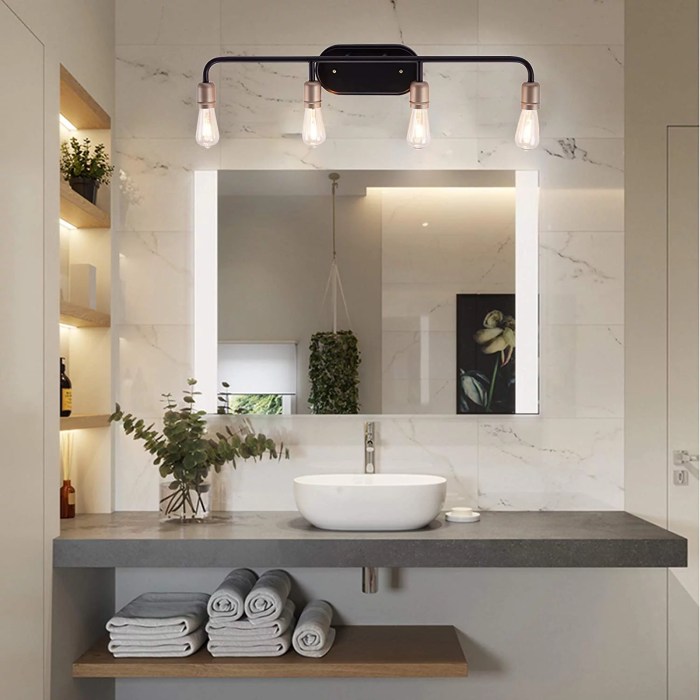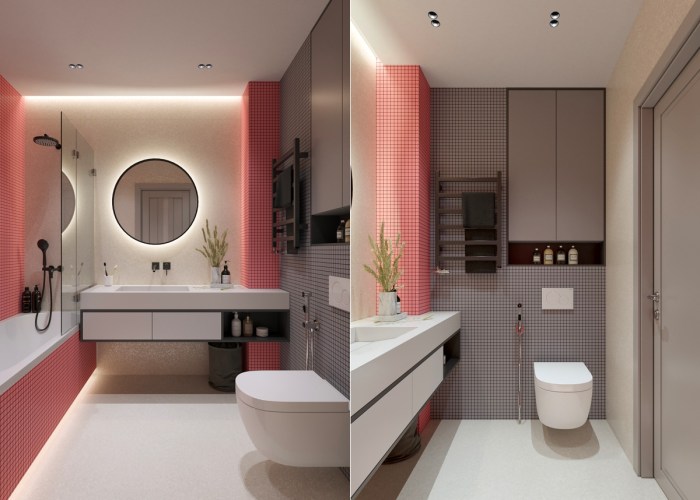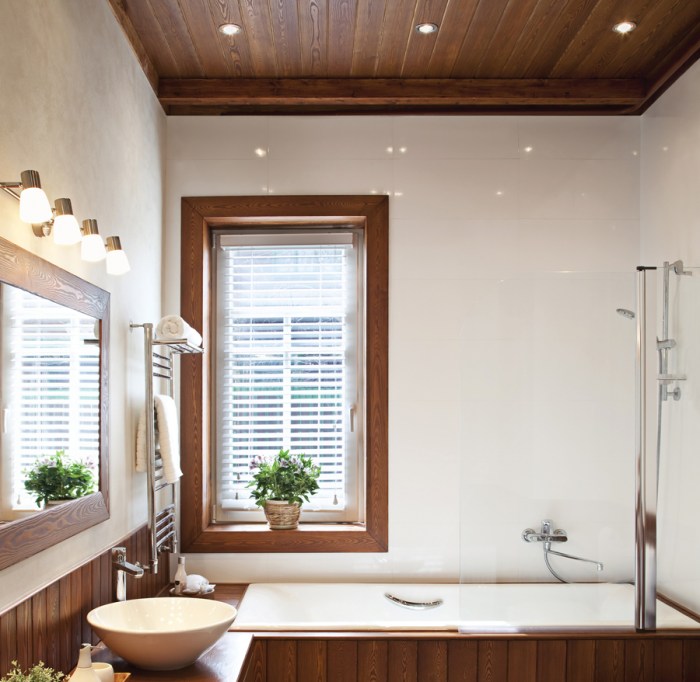When it comes to small bathrooms, lighting is key to creating a sense of spaciousness and ambiance. With the right lighting design, you can transform a cramped space into a bright and inviting haven. In this comprehensive guide, we will delve into the world of small bathroom lighting, exploring different types of fixtures, the importance of natural light, and creative DIY ideas to enhance the functionality and aesthetics of your tiny bathroom.
From choosing the perfect vanity lights to maximizing the use of natural light, we will provide you with all the inspiration and practical tips you need to create a small bathroom that is both functional and stylish. Get ready to illuminate your bathroom and discover the transformative power of lighting design.
Lighting Fixtures
When designing lighting for a small bathroom, it’s crucial to choose fixtures that complement the space and enhance its functionality. Consider recessed lighting, sconces, and vanity lights to illuminate your bathroom effectively.
Recessed Lighting
Recessed lighting is installed flush with the ceiling, providing a clean and modern look. It offers diffused, ambient lighting, making it suitable for general illumination. However, it can be more expensive to install and may require professional assistance.
Sconces
Sconces are wall-mounted fixtures that provide task lighting near mirrors and vanities. They come in various styles, from traditional to contemporary, and can create a warm and inviting atmosphere. However, they may not provide sufficient general illumination for the entire bathroom.
Vanity Lights
Vanity lights are installed above or around mirrors, offering focused lighting for tasks like shaving, applying makeup, or grooming. They provide excellent task lighting but may not illuminate the entire bathroom evenly. Choose fixtures with adjustable shades or bulbs to customize the light direction.
Natural Light
Incorporating natural light into small bathrooms can significantly enhance their ambiance and make them feel more spacious. By maximizing natural light, you can create a brighter, more inviting, and energy-efficient space.
There are several effective ways to maximize natural light in small bathrooms:
Skylights
- Skylights are an excellent option for introducing natural light into bathrooms that lack windows or have limited access to natural light. They can be installed on the ceiling or roof and provide ample daylight, even in small spaces.
Windows
- Windows are another effective way to bring natural light into bathrooms. When choosing windows for small bathrooms, consider the size, placement, and type of window. Larger windows will allow more light to enter, while windows placed strategically can maximize the distribution of natural light throughout the space.
Mirrors
- Mirrors can reflect natural light and make small bathrooms appear larger and brighter. Place mirrors opposite windows or skylights to reflect and amplify the available natural light.
Window Placement and Size
The placement and size of windows significantly impact the amount and distribution of natural light in a bathroom. Consider the following factors when choosing windows for your bathroom:
- Window placement: Windows placed high on the wall or near the ceiling will allow more natural light to enter the space.
- Window size: Larger windows will allow more light to enter the bathroom. However, ensure the window size is proportional to the size of the bathroom to avoid overwhelming the space.
Color and Contrast
Color and contrast play a crucial role in creating the illusion of space in small bathrooms. Light and airy colors reflect light, making the room feel larger. Examples include white, beige, light gray, and pale blue.
Contrasting colors can define different areas and add visual interest. For example, a dark accent wall can draw attention to a specific area, such as the vanity or shower. Contrasting colors can also be used to create a focal point, such as a brightly colored shower curtain or rug.
Color and Space
- Light colors reflect light, making the room feel larger.
- Dark colors absorb light, making the room feel smaller.
- Contrasting colors can define different areas and add visual interest.
Lighting Layout
Optimizing lighting layout is crucial for a well-lit bathroom. Consider the following steps:
Task Lighting
Focus on areas where specific tasks occur, such as the mirror, vanity, and shower. Use wall-mounted sconces, under-cabinet lights, or LED strips for precise illumination.
Ambient Lighting
Provide general illumination throughout the bathroom. Use a ceiling light fixture, recessed lighting, or a combination to create a balanced and comfortable atmosphere.
Accent Lighting
Highlight architectural features, artwork, or decorative elements with accent lighting. Use track lighting, picture lights, or recessed spotlights to draw attention to desired areas.
Optimal Lighting Placement
| Area | Lighting Type | Placement |
|---|---|---|
| Mirror | Task Lighting | On either side or above the mirror |
| Vanity | Task Lighting | Under cabinets or on the countertop |
| Shower | Task Lighting | Recessed lighting or wall-mounted fixtures |
| Ceiling | Ambient Lighting | Centered or evenly spaced |
| Decorative Elements | Accent Lighting | As desired to highlight specific features |
Energy Efficiency
Small bathrooms often require careful planning to achieve adequate lighting without breaking the bank or sacrificing style. Energy-efficient lighting fixtures can help you save money on your energy bills while still providing plenty of light. They are also a more sustainable option, as they use less energy and produce less greenhouse gases.
There are several different types of energy-efficient lighting technologies available, including LEDs, CFLs, and halogens. LEDs are the most energy-efficient option, and they also last longer than other types of bulbs. CFLs are also energy-efficient, and they are more affordable than LEDs.
Halogens are not as energy-efficient as LEDs or CFLs, but they produce a brighter light.
Tips for Reducing Energy Consumption
- Use natural light whenever possible. Open curtains or blinds to let in the sun.
- Choose light fixtures with built-in dimmers. This will allow you to adjust the light level to suit your needs.
- Turn off lights when you leave the room.
- Unplug chargers and other electronics when you’re not using them.
DIY Lighting Ideas
Transform your small bathroom with creative and affordable DIY lighting ideas. Unleash your inner designer and personalize your space with unique and functional illumination.
Mason Jar Pendant Lights
Materials:
- Mason jars
- Cord and sockets
- Hooks or brackets
- Drill
- Paint or decorative paper (optional)
Steps:
- Drill a hole in the lid of each mason jar.
- Insert the cord and socket into the hole.
- Attach the hooks or brackets to the ceiling.
- Hang the mason jars from the hooks or brackets.
- Paint or decorate the mason jars as desired.
Rope Light Mirror Surround
Materials:
- Rope light
- Mirror
- Adhesive
Steps:
- Apply adhesive around the edges of the mirror.
- Attach the rope light to the adhesive.
- Plug in the rope light.
Fairy Light Canopy
Materials:
- Fairy lights
- Hoop or embroidery ring
- Fabric or sheer material
- Hooks or clips
Steps:
- Attach the fairy lights to the hoop or embroidery ring.
- Drape the fabric or sheer material over the hoop.
- Secure the fabric with hooks or clips.
- Hang the canopy from the ceiling.
Outcome Summary
As you embark on your small bathroom lighting journey, remember that the key lies in creating a balance between functionality and aesthetics. By carefully considering the type of fixtures, the placement of natural light sources, and the use of color and contrast, you can transform your small bathroom into a space that is both practical and inviting.
Don’t be afraid to experiment with different lighting ideas and find what works best for your unique space. With a little creativity and planning, you can create a small bathroom that feels both spacious and stylish.



